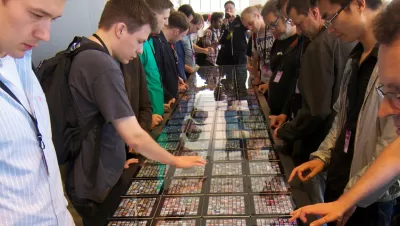By now most planners agree that, in general, projects that don’t directly and negatively affect people, don’t generate a lot of public discussion. And residents who show up at public meetings tend to be the same characters weeks after weeks.

In a national citizen survey conducted by the National Research Center, 76 per cent of adults age 35 to 44 never attended a local public meeting. 76 per cent! Think about 10 people you know well. According to this survey, eight of them will never attend a public meeting.
By now most planners agree that, in general, projects that don’t directly and negatively affect people, don’t generate a lot of public discussion. And residents who show up at public meetings tend to be the same characters weeks after weeks. It’s really hard to get people talking about a project if it’s close to them.
So, some local governments are taking steps to remedy this situation by going to where people are. Park City’s Mayor Thomas goes door-to-door along the town’s main corridor to gauge resident sentiment about everything from new development projects to air quality and garbage pickup.
The latest initiative from the City of Vancouver - Pop-Up City Hall - is a testament to how cities are stepping outside city hall and meeting with citizens on the streets.
Social media networking sites and the internet is a place where people hang out a lot. On average Canadians spend 45 hours per month for surfing the internet. 79 per cent of American adults said they use the internet regularly and nearly half of adults say they use at least one of social media networking sites.
Given the amount of time we spend online, it makes sense that connecting with citizens online is another step in moving towards making it convenient for citizens to connect with their local government while increasing participation in projects.
Plus social networks provide a direct and targeted way to communicate with citizens. This is exactly what you need to foster trust and create connections. Social media network communication will become an essential part of the engagement mix for planners, engineers and architects involved in projects of all scales.
The biggest question is which social media networking sites you should put effort into? How can I choose the most relevant site for my project?
First of all: Understanding your audience is everything
Having a solid understanding of who your target citizen is and what type of content he or she is interested in, will go a long way. Baby boomers are on Facebook and Millennials hang out on Twitter.
To avoid wasting time because your target audience is not on the social media site you’re using, you need to narrow the social media playing field and figure out where they are – what networks they are most likely to congregate on.
Here are some considerations before you select the right social media network for your planning project:
Facebook is right for your project if…most of your audience is adults. 71per cent of online adults are on Facebook. And 84 per cent of online adults who use Facebook are between 18 and 29 years old, followed by 79 per cent of 30-49 years old.
The primary reason people use Facebook is to connect with family and immediate friends. And given that most people want to engage with local governments the same way they engage with their friends, Facebook makes the perfect platform for sharing embedded links and images. In other words, content that people can easily share and like.
In that respect, Facebook is more about driving traffic. It’s the perfect medium for driving traffic to your online engagement space or website. Facebook users are more politically engaged.
63 per cent of users will visit at least once a day. The time of day varies based on the age group. A Buddy Media’s study found that engagement rates for Facebook are higher on Thursday and Friday. As they put it, “the less people want to be at work, the more they are on Facebook!”.
Twitter is right for your project if…you are targeting a slightly younger age group and you are looking to promote trust and accountability.
Twitter is more of a communication device and less of a pure social media site. Twitter is where people go to find news. Twitter is a very helpful tool to find resources, news and communicating with people. Its open interface makes it the ideal platform to promote trust and accountability.
46 per cent of users will visit at least once a day.
LinkedIn is right for your project if…You are trying to appeal to a slightly more educated and professional-centric audience and if you are trying to get people to visit your project website or online engagement space. With roughly 500 million users, LinkedIn is the third fastest growing social media networking site.
Facebook and Twitter are the best social media sites when it comes to sharing content. But when it comes to driving traffic to your main organization’s site, or online engagement space, LinkedIn is the way to go. According to Investi IQ Research, LinkedIn is the biggest source of visit from social media sites.
One of the big and deliberate roadblocks to using LinkedIn is that you can only contact people you already know.
Instagram is right for your project if…You are looking for inspiration, trying to create visual representation of your community, and if you are targeting a predominantly young audience.
In a 2013 Pew Research Study, 54 per cent of internet users have posted an original photo or video that they personally have created. Why? Because images inspire. They’re a great way to foster emotional connections and elicit feedback.
Images are often used in visioning exercises to create a vision for a community. They’re also great at helping identify design standards that reflect community values and preferences.
How do you choose the right social media network for your projects?
As we push forward with social media for engaging with residents on projects, we’ll learn a lot and continue to experiment with new tips and tools.
I would love to hear your thoughts on the topic. Share any and ideas here in the comments or on Twitter @simolapointe.
FULL STORY: How to choose the right social media for your planning project

Planetizen Federal Action Tracker
A weekly monitor of how Trump’s orders and actions are impacting planners and planning in America.

Chicago’s Ghost Rails
Just beneath the surface of the modern city lie the remnants of its expansive early 20th-century streetcar system.

San Antonio and Austin are Fusing Into one Massive Megaregion
The region spanning the two central Texas cities is growing fast, posing challenges for local infrastructure and water supplies.

Since Zion's Shuttles Went Electric “The Smog is Gone”
Visitors to Zion National Park can enjoy the canyon via the nation’s first fully electric park shuttle system.

Trump Distributing DOT Safety Funds at 1/10 Rate of Biden
Funds for Safe Streets and other transportation safety and equity programs are being held up by administrative reviews and conflicts with the Trump administration’s priorities.

German Cities Subsidize Taxis for Women Amid Wave of Violence
Free or low-cost taxi rides can help women navigate cities more safely, but critics say the programs don't address the root causes of violence against women.
Urban Design for Planners 1: Software Tools
This six-course series explores essential urban design concepts using open source software and equips planners with the tools they need to participate fully in the urban design process.
Planning for Universal Design
Learn the tools for implementing Universal Design in planning regulations.
planning NEXT
Appalachian Highlands Housing Partners
Mpact (founded as Rail~Volution)
City of Camden Redevelopment Agency
City of Astoria
City of Portland
City of Laramie






























